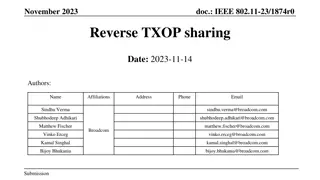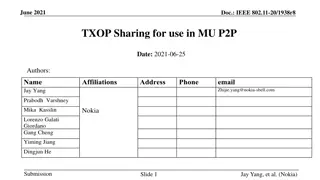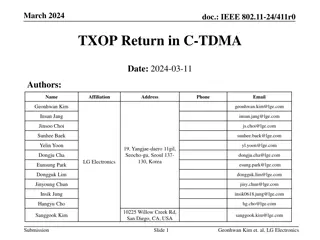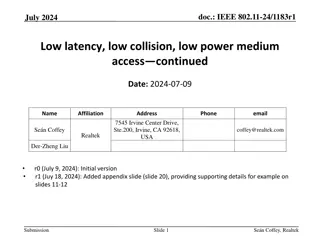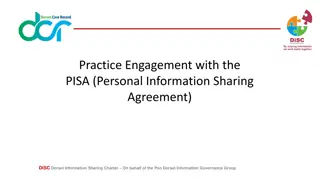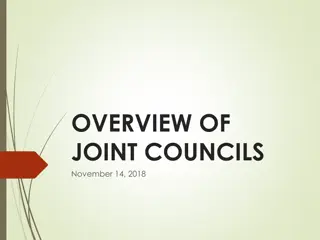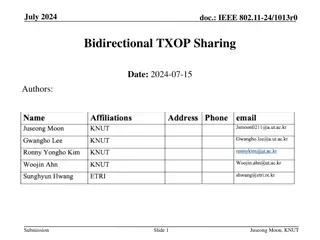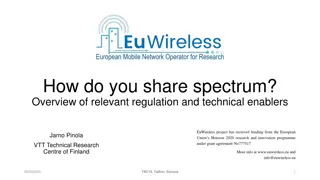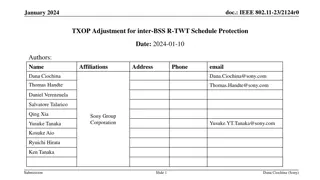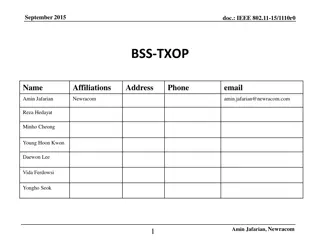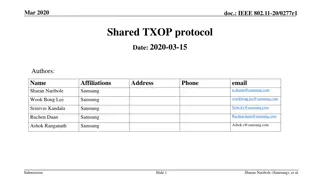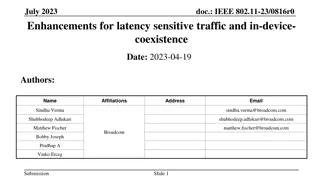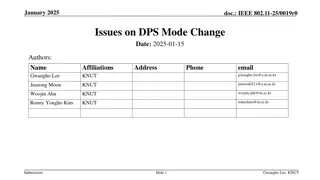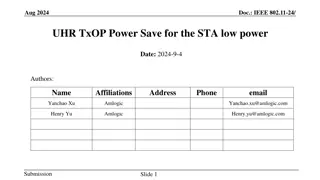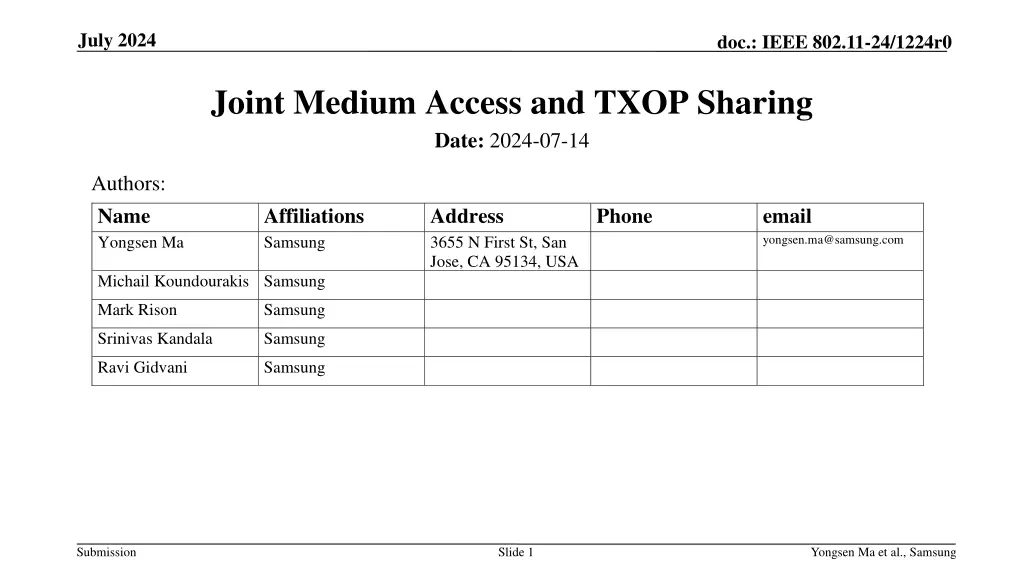
IEEE 802.11-24/1224r0: Joint Medium Access and TXOP Sharing in July 2024
Explore the IEEE 802.11-24/1224r0 document from July 2024, detailing mechanisms for medium access and TXOP sharing for UL/DL/P2P traffic among STAs and APs. Discover how contention and backoff processes work, along with trigger frame initiation and TXOP sharing scenarios.
Download Presentation

Please find below an Image/Link to download the presentation.
The content on the website is provided AS IS for your information and personal use only. It may not be sold, licensed, or shared on other websites without obtaining consent from the author. If you encounter any issues during the download, it is possible that the publisher has removed the file from their server.
You are allowed to download the files provided on this website for personal or commercial use, subject to the condition that they are used lawfully. All files are the property of their respective owners.
The content on the website is provided AS IS for your information and personal use only. It may not be sold, licensed, or shared on other websites without obtaining consent from the author.
E N D
Presentation Transcript
July 2024 doc.: IEEE 802.11-24/1224r0 Joint Medium Access and TXOP Sharing Date: 2024-07-14 Authors: Name Yongsen Ma Affiliations Samsung Address 3655 N First St, San Jose, CA 95134, USA Phone email yongsen.ma@samsung.com Michail Koundourakis Samsung Mark Rison Samsung Srinivas Kandala Samsung Ravi Gidvani Samsung Submission Slide 1 Yongsen Ma et al., Samsung
July 2024 doc.: IEEE 802.11-24/1224r0 Abstract The spec defines mechanisms to get medium access for UL/DL/P2P traffic Each STA/AP tries to get medium access by CSMA/CA. For a group of STAs, e.g., P2P group, there might be two levels of contention/backoff from both inter-group and intra-group STAs. This submission presents joint medium access and TXOP sharing Medium access for DL data initiated from non-AP STA Trigger/polling frame initiated from non-AP STA TXOP sharing initiated from non-AP STA Submission Slide 2 Yongsen Ma et al., Samsung
July 2024 doc.: IEEE 802.11-24/1224r0 Introduction: TXOP for UL/DL/P2P Traffic (1/2) The spec defines mechanisms to get medium access for UL/DL/P2P traffic Each STA/AP tries to get medium access by CSMA/CA. UL/DL/P2P traffic may be in the same TXOP, e.g., using TXS, RDG and MU cascading. If AP gets medium access: AP may use trigger frame to initiate UL/DL transmissions with certain STA(s). AP may use trigger based TXOP sharing (TXS) to allow the non-AP STA (TXOP responder) to send UL data to AP (sharing mode 1) or send P2P data to another peer STA (sharing mode 2). Submission Slide 3 Yongsen Ma et al., Samsung
July 2024 doc.: IEEE 802.11-24/1224r0 Introduction: TXOP for UL/DL/P2P Traffic (2/2) TXOP holder Primary traffic direction Procedures and examples AP UL AP adds trigger/poll in TX queue -> AP gets TXOP and sends trigger/poll to STA(s) -> STA(s) sends UL data to AP Note: DL data can be accommodated by RDG DL AP adds data in TX queue -> AP gets TXOP -> AP sends DL data to STA(s) Note: UL data can be accommodated by RDG, TXS, or MU cascading P2P AP uses TXS sharing mode 2 for P2P transmission from the TXOP responder to another P2P STA Non- AP STA P2P STA adds data in TX queue -> STA gets TXOP by CSMA/EDCA or TXS -> STA sends data to another P2P STA Other options: medium access as a group and TXOP sharing within the group UL STA adds data in TX queue -> STA gets TXOP -> STA sends UL data to AP Note: DL data can be accommodated by RDG Other options to accommodate DL data, e.g., indication in MAC header of UL data (from non-AP STA) or BA (from AP) DL Non-AP STA wants to receive DL data or wants poll for DL data: RX/L2 buffer status at non-AP STA or more DL data indication from AP or non-AP STA -> non-AP STA tries to get channel access by EDCA or TXOP sharing -> non-AP STA gets TXOP and sends poll/request to AP -> AP sends DL data to non-AP STA Non-AP STA adds a poll/request frame in TX queue (similar to BSRP) -> non-AP STA gets TXOP and sends poll/request to AP -> AP sends DL data or CF-END to non-AP STA Slide 4 Submission Yongsen Ma et al., Samsung
July 2024 doc.: IEEE 802.11-24/1224r0 Non-AP STA as TXOP Holder for DL Data (1/2) Use cases when a non-AP STA wants to get TXOP for DL data AP has DL data (cannot be finished in the previous TXOP) and indicates more DL data across TXOP. Non-AP STA sends UL data in the previous/current TXOP and expects DL data, e.g., bidirectional traffic. Non-AP STA has pending data in RX/L2 buffer and needs to get the remaining DL data from AP. Non-AP STA adds poll/request frame in TX queue (before/after getting TXOP) and asks AP for DL data. The indication/poll/request can be cross-link for MLDs. Submission Slide 5 Yongsen Ma et al., Samsung
July 2024 doc.: IEEE 802.11-24/1224r0 Non-AP STA as TXOP Holder for DL Data (2/2) Potential benefits: AP gets TXOP for DL data with the help from non-AP STA: non-AP STA performs CSMA/CA for DL data, more data indication from AP/non-AP and MLO. Instead of waiting for AP to get the TXOP, non-AP STA also tries to get TXOP for DL data, sends/ receives more data indications to/from AP for more DL data, or polls from AP for more DL data. Both non-AP STA and AP try to get medium access for DL data. If non-AP STA gets the TXOP before the AP, DL data can be delivered faster, without increasing the chance of collision or backoff. More data indication is sent in the obtained TXOP, so AP and non-AP STA can take actions quickly. Can take advantage of MLD with cross-link medium access: more data indication on one link and data transmissions on another link. Similar concept for other cases for a group of STAs (more details on following slides) Submission Slide 6 Yongsen Ma et al., Samsung
July 2024 doc.: IEEE 802.11-24/1224r0 Joint Medium Access and TXOP Sharing (1/2) Existing: for a group of STAs, e.g., P2P, relay, soft AP, multi-AP: Each STA tries to get medium access by CSMA/CA. AP may share the TXOP with certain STA(s), e.g., TXS, MU TXS [1, 2, 3] and data forwarding [4]. There might be two levels of contention/backoff from both inter-group and intra-group STAs, which may increase the chance of collisions and wasted/unused TXOP. Proposal: medium access as a group with TXOP sharing Each STA tries to get medium access by CSMA/CA. If group leader gets the TXOP, it may use trigger based transmissions to serve peer STA(s). If any group STA other than group leader gets the TXOP, it may transfer the TXOP to group leader and group leader initiates DL/UL/P2P transmissions with peer STA(s). Medium access is done in a semi-distributed way and does not require participation/initiation from AP. It helps to avoid in-group contention/backoff and therefore avoid collisions and wasted/unused TXOP. It helps to get medium access quicker for high priority STA/traffic, reduce latency, and have grouped DL/UL/P2P traffic in the same TXOP. Submission Slide 7 Yongsen Ma et al., Samsung
July 2024 doc.: IEEE 802.11-24/1224r0 Joint Medium Access and TXOP Sharing (2/2) Use Case DL from AP to Non-AP STA Current AP tries to get TXOP for DL data AP shares UL TXOP for DL data, e.g., RDG, TXS Each group STA tries to get TXOP. If a group STA gets TXOP, it may initiate TX/RX with peer STA(s) or AP. If AP shares TXOP with a group STA, the group STA may transmit to another group STA or AP. Each group STA needs EDCA or wait for frame from peer STA to get access to the channel. Can extend TXS with help from AP [1, 2, 3, 4, 5] for bidirectional traffic and P2P/relay STAs. Proposed Non-AP STA helps to get TXOP for DL data, similar as reverse TXOP sharing [6]. If group leader gets TXOP, it may use trigger/polling frame to initiate TX/RX with peer STA(s) and/or initiate TX/RX with AP. If any group STA gets TXOP, it may share the TXOP to the group leader and the group leader may initiate TX/RX with peer STA(s), similar as non-AP STA initiated TXOP sharing [7, 8] P2P Proxy Mesh Relay Soft AP Multi-AP Submission Slide 8 Yongsen Ma et al., Samsung
July 2024 doc.: IEEE 802.11-24/1224r0 Example 1: TF from STA1 and TXOP Sharing from STA2 STA1 gets TXOP STA1 sends trigger frame (plus polling if needed) to STA2 and STA3 STA2 and STA3 transmit/receive with STA1 based on the scheduling/RU allocation in TF STA2 gets TXOP STA2 sends control frame to STA1 to share the TXOP with STA1 STA1 sends trigger frame to STA2 and STA3 STA2 and STA3 transmit/receive with STA1 Submission Slide 9 Yongsen Ma et al., Samsung
July 2024 doc.: IEEE 802.11-24/1224r0 Example 2: TF from STA1 and STA2 STA1 gets TXOP STA1 sends trigger frame to STA2 and STA3 and initiates transmissions with STA2 and STA3 STA2 gets TXOP STA2 sends trigger frame to STA1 and STA3 and initiates transmissions with STA1 and STA3 Example 1: only STA1 can send TF Example 2: STA1 and STA2 can send TF Submission Slide 10 Yongsen Ma et al., Samsung
July 2024 doc.: IEEE 802.11-24/1224r0 Example 3: P2P TXOP Shared for UL/DL Traffic STA1 gets TXOP STA1 sends trigger frame to STA2 and STA3 STA1 initiates transmissions with STA2, STA3, and AP STA2 gets TXOP STA2 sends control frame to STA1 to share the TXOP with STA1 STA1 sends trigger frame to STA2 and STA3 STA1 initiates transmissions with STA2, STA3, and AP Submission Slide 11 Yongsen Ma et al., Samsung
July 2024 doc.: IEEE 802.11-24/1224r0 Conclusion This contribution presents joint channel access and TXOP sharing Medium access for DL data initiated from non-AP STA Trigger/polling frame initiated from non-AP STA TXOP sharing initiated from non-AP STA It helps to avoid in-group contention/backoff and hence to avoid potential collisions and wasted TXOP. It allows channel access being done in a semi-distributed way and does not require participation or initiation from the AP. It provides additional options to get medium access for a group of STAs and can coexist with other options, e.g., EDCA, trigger-based access, TXS, and multi-STA TXOP sharing. Submission Slide 12 Yongsen Ma et al., Samsung
July 2024 doc.: IEEE 802.11-24/1224r0 References [1] 802.11-24/0403r0, Managed on-channel P2P communication, Inaki Val [2] 802.11-24/0536r0, Multi-user triggered TXOP sharing, Ronny Yongho Kim [3] 802.11-24/0105r0, TXOP for Relay communication in 11bn, Dongguk Lim [4] 802.11-24/0668r1, Data Forwarding within TXOP for XR Use Cases, Seongho Byeon [5] 802.11-24/0393r0, Enhancements on Off-Channel P2P Communications, Rubayet Shafin [6] 802.11-23/1874r0, Reverse TXOP Sharing, Sindhu Verma [7] 802.11-24/0686r0, STA initiated TXOP Sharing via Unicast CF-End, Pei Zhou [8] 802.11-23/1847r0, Non-AP initiated TXOP sharing follow-up, Sanghyun Kim Submission Slide 13 Yongsen Ma et al., Samsung

